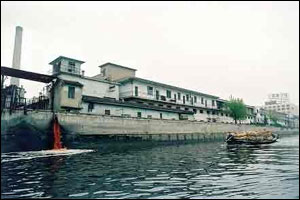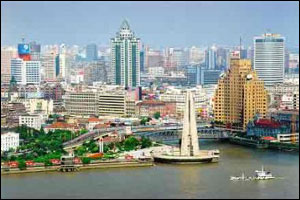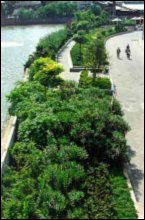
| ISSUE N° 4 July 2003 |
|
Report on Shanghai Water Projects Download Shanghai Flash N° 4/2003 pdf-version
'A glass of water with half a glass of dirt' was the vivid picture of the quality of drinking water in Shanghai some 25 years ago. People could still clearly remember the strange taste of the water at that time. Half a century's industrialisation not only led to Shanghai's fast development, but also to serious environmental problems. As the Chinese saying goes, a city with a river running through it is a city full of life. But this cannot be applied to Shanghai. Having two heavily polluted rivers running across the city, the Huangpu River and the Suzhou Creek, Shanghai has to deal with two problematic water currants. Back to even five years ago, walking along the famous Bund area was not a pleasant experience because of the bad smell emanating from the Huangpu River. For people living close to the Suzhou Creek, the situation was even worse. People had to keep windows closed day and night to avoid the foul smell from the water in the neighbourhood. Instead of being green and clear, the Creek was black and opaque, full of sewage. The drinking water for urban residents is seriously polluted as it comes mainly from outlying sections of these two rivers - the upper stretch of the Huangpu River near the Songpu Bridge in Minhang District, and the river mouth where the Yangtze River merges with the East China Sea. Faced with the threat of worsening water pollution, and demands of meeting international environmental standards, the Shanghai government decided to adopt measures for improving the environmental situation in the city. The municipal government has listed Shanghai's rivers at the top of its environmental agenda. The rehabilitation project of the Suzhou Creek is the key issue on this agenda. Other than the Suzhou Creek Rehabilitation Plan, the municipal government has taken steps to improve the water situation by building more sewage treatment facilities. Over the past two decades Shanghai has spent over 10 billion yuan on sewage treatment and treatment facilities, including the building of 31 sewage treatment plants. Over the next two years the Shanghai government will set up another 27 new sewage treatment plants as well as investing heavily in new and bigger waste water pipes to further increase the city's capacity of disposing waste water. Shanghai's plans on waste water treatment, water saving and building green areas have influenced the traditional socialist economic structure in this sector. Private enterprises and foreign investment emerges in the former government sector in relation to the many environmental projects, showing a growing impact of the market economy on a key sector of urban well-being. SUZHOU CREEK REHABILITATION PLAN About the Suzhou Creek Suzhou Creek, originating in Gua Jing Kou, Jiangsu Province, is one of the biggest tributaries of the Huangpu River. The Creek is about 125- km long, of which 53.1 km are lying within the boundary of the Shanghai municipality and 23.8 km are within the city proper. The average width of the Creek is about 70-80 m. The average depth is 2 to 4 metres at low tide and about 7 to 8 metres at high tide. According to the statistics of the hydrologic station in the Huangpu district, the average net flow is 6m3/s, while at the river mouth it is more than 10m3/s, of which 40-60% is contributed by the inflow of domestic and industrial waste water along the banks. At present, the Creek serves many functions, including flood prevention, navigation, industrial water supply, irrigation, and aquatics breeding. Flood prevention is of high importance in a region traditionally subjected to regular flooding. There are six main local tributaries to the Creek - Mudugang, Pengyuepu, Zhenrugang, Huacaogang, Xinjinggang and Shenjigand.
In the first decade of the 20th century, the creek was quite clean. But starting in the 1920s, continuous pollution led to a deterioration of the creek and from the 1950s, the pollution became even heavier. More and more industries poured untreated waste into the waterway and, as the city's population swelled, too many people began using the creek as a place to dump their domestic trash and sewage. The pollution avalanche resulted in the death of the river - there was no fish or plant life in the river any longer. Suzhou Creek Rehabilitation Plan In 1996 the President of the P.R.China, Jiang Zeming, strongly insisted that the Suzhou Creek be treated. As a result the Shanghai Municipal Government established the Suzhou Creek Rehabilitation Leader Group and further increased the legal power of the Group in 1998 and 2000. The Group was directed by Mr. Xu Kuangdi, the mayor of Shanghai at that time, Mr. Chen Liangyu, the standing V-M and the actual Secretary, Mr. Han Zhen, a V-M at that time and the present mayor. The organisation of the Group highlighted the importance given to the rehabilitation of the Suzhou Creek among all the projects dealing with environmental issues in Shanghai. The municipal government has been attaching more and more importance to the rehabilitation plan during the following years. The government obviously hopes, through the treatment of the Suzhou Creek, to improve the general water situation of other middle and small sized rivers in Shanghai.
In 1998, the first phase of the Suzhou Creek Rehabilitation Plan was launched. During this first phase three main aims were followed, namely the reduction of sewage discharge into the river, the installation of a water lock between Huangpu river and Suzhou Creek and the input of oxygen into the dead river. The first phase of the Rehabilitation Plan has been completed in 2003 with a total investment of around 7 billion yuan (US$ 84 million). The creek's water quality has reached the fifth level of national classification by the beginning of 2003 when the first phase of the Rehabilitation project has been successfully completed, with a total investment of about 6.89 billion yuan. The water is getting clearer. The foul smell is disappearing. The city has managed to beautify the landscape along the Creek in the downtown area, changing it to be one of the heated real estate markets in the city center. Statistics show that prices for houses along the waterway are 10 to 15 percent higher than for housing only a little away from the creek. To own an apartment close to the Creek is becoming a dream for local residents. The concept of Riverside Residence is starting to make real sense.
After the completion of the first phase in January 2003, the municipal government started the second phase. It will be completed in the year of 2005. The second phase of the Rehabilitation Plan, with an estimated investment of 3.94 billion yuan, remains the top priority of the second round of the city's three-year environmental plan. The goal of the second phase is to maintain and improve the current water quality, to tackle the problems of the six tributaries, and to build large areas of green space along the Suzhou Creek. In addition to consolidating the achievement of the first phase, more landscaping of the creek's banks and bridges is the key component in the second phase. Sewage treatment and blocking off the pollution sources are the major tasks. The main projects are
The whole Suzhou Creek Rehabilitation Plan is supposed to be completed by the year 2010. By implementing the project the government hopes to improve not only the natural environment and the quality of life for local residents, but also the city's international image and attractiveness. The results of the Plan can be literally seen so far. However, a big improvement of the quality of water will still take time to show. One of the reasons is the fact that Taihu Lake, the main source of the river, is still severely polluted. Another reason is that some people still fail to realise the importance of protecting the environment and continue to dump waste into the Creek. OTHER PROJECTS RELATED TO THE SHANGHAI WATER SYSTEM Large Sewage Treatment Plants under Construction Shanghai has spent over 10 billion yuan over the past two decades on sewage treatment, including the building of 31 sewage treatment facilities. However sewage treatment is still a major issue for the city. Currently the city only treats about 44 percent of the 5.40 million tons of waste water produced every day, with the rest still flowing directly into local rivers. The construction of two large sewage treatment plants began in June 2002. The Zhuyuan No. 1 sewage treatment plant and the Bailonggang plant could process 1.7 million and 1.2 million tons of waste water daily respectively. The two plants cost a total of 1.48 billion yuan and are expected to be in service by the end of 2003. Including to the above two plants, the government will set up 27 new sewage treatment plants as well as more waste water pipes by 2005. Once the new facilities are in place, the city should be able to treat 76 percent of the waste water it produces. During the second phase of the Suzhou Creek Rehabilitation Plan, more emphasis will be put on building green areas along the banks of the Suzhou Creek to meet the goal of the Shanghai government to change the Creek into a natural garden for leisure and tourism, and to realise the dream of turning it into the Oriental Seine. The Shanghai government has planned to build more than 100 hectares of green areas. Green Lounge under construction now is about 1.1 hectares, with a length of 1.6 kilometres.
With the city's population expected to increase only marginally and in spite of a continuous economic development until 2020, the water authority in Shanghai claims that Shanghai's water consumption will not increase from its present volume. Saving one cubic meter of water means saving urban infrastructure costs of 10,000 yuan (US$ 1,200). In the year of 2001, Shanghai saved 300 million cubic meters of water by readjusting the industrial structure and by employing new technology. Shanghai lacks drinking water. The Huangpu River, supplying 80 percent of the city's drinking water, is . Besides penning regulations, the authority is popularising technology among the public to cut the amount of used water. At present, the city has about 600,000 family toilets, each using 13 litres of water per flush. These are to be renovated to use only 9 litres of water per flush. In three years, all the toilets must be renovated, saving the city nearly 15 million yuan (US$ 1.82 million) annually in water treatment. Shanghai will adopt information technology in its water treatment and establish an IT framework to digitise services by the year 2007. CHANGES IN FINANCIAL INFRASTRUCTURE RELATED TO THE WATER PROJECTS Shanghai has planned an investment of 50 billion yuan (US$6.05 billion) over five years to reposition itself as a world-class river city with clean and safe water resources. The private sector, including foreign companies, starts to play a role in government environmental projects, which used to be exclusively governmental. Thanks to the flexible operating mechanisms of the local government and thanks to a strong desire for municipal growth, private enterprises and foreign lending institutions are slowing becoming elements in terms of involvement. The ongoing rehabilitation project of the Suzhou Creek and the large scale development of green areas in the city all require a stronger participation from the non-state sector. The Asian
Development Bank (ADB) financed part of the Suzhou Creek Rehabilitation
Plan. The city also negotiated with the World Bank for loans to
finance its sewage treatment infrastructure; Thames LLP and Bovis
of the UK joined in the financing of the Dachang water-treatment
plant; the Shanghai-based Youlian Enterprise Development French company Vivandi Water Works in Shanghai has worked with the Shanghai Tong Ji University on developing the technology to improve the quality of drinking water. The company has also got involved in water saving and leak detection projects. POTENTIAL FOR SWISS BUSINESS The environmental projects of Shanghai government could be a potential market for Switzerland in fields of Swiss waste water treatment products/system and financial services. Some Swiss companies (such as ABB) have started co-operation with the Shanghai government on waste water treatment projects but there is still a large scale of demands on this sector. Shanghai also needs a lot of support on water saving and water recycling. Switzerland has not had any financial co-operation with the Shanghai government yet. In spite of the increasingly open attitude to private enterprises and foreign companies, the Shanghai government is still very cautious in giving out detailed information about the governmental projects. Swiss financial institutions such as SOFI and Swiss Mixed Credit could get involved in the Shanghai's environmental projects by offering financial aids. Shanghai also needs contributions in terms of reconstruction and beautification of the Riverside area. Take e.g., the development of Northern Bund area. Northern Bund area, the area along the bank of the Huangpu River and to the north of the Suzhou Creek, is supposed to be another new zone forming a triangle together with Pudong Lujiazui area and the original Bund area. Lots of constructions will take place, among them a twin tower of a height of around 100 meters is set to become another thematic scene of Shanghai. By SONG Yujia 18.7.2003 Consulate
General of Switzerland |
Back to the top of the page
Page created and hosted by SinOptic


 Greenbelts
Along the Riverside of the Suzhou Creek
Greenbelts
Along the Riverside of the Suzhou Creek